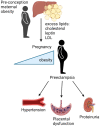An Overview of Obesity, Cholesterol, and Systemic Inflammation in Preeclampsia
- PMID: 35631228
- PMCID: PMC9143481
- DOI: 10.3390/nu14102087
An Overview of Obesity, Cholesterol, and Systemic Inflammation in Preeclampsia
Abstract
Preeclampsia (PE), an inflammatory state during pregnancy, is a significant cause of maternal and fetal morbidity and mortality. Adverse outcomes associated with PE include hypertension, proteinuria, uterine/placental abnormalities, fetal growth restriction, and pre-term birth. Women with obesity have an increased risk of developing PE likely due to impaired placental development from altered metabolic homeostasis. Inflammatory cytokines from maternal adipose tissue and circulating cholesterol have been linked to systemic inflammation, hypertension, and other adverse outcomes associated with PE. This review will summarize the current knowledge on the role of nutrients, obesity, and cholesterol signaling in PE with an emphasis on findings from preclinical models.
Keywords: cholesterol; cytokines; hypertension; inflammation; leptin; metabolic abnormalities; obesity; preeclampsia.
Conflict of interest statement
The authors declare no conflict of interest.
Figures

References
-
- Herraiz I., Llurba E., Verlohren S., Galindo A., Spanish Group for the Study of Angiogenic Markers in Preeclampsia Update on the Diagnosis and Prognosis of Preeclampsia with the Aid of the SFlt-1/ PlGF Ratio in Singleton Pregnancies. Fetal Diagn. Ther. 2018;43:81–89. doi: 10.1159/000477903. - DOI - PubMed
Publication types
MeSH terms
Substances
Supplementary concepts
Grants and funding
LinkOut - more resources
Full Text Sources
Medical

